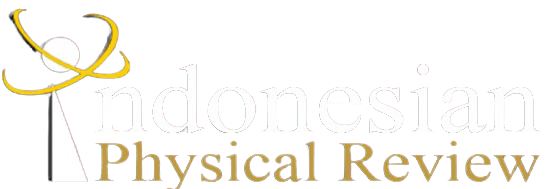THE LITHOLOGY OF FLOOD PRONE AREAS USING THE VERTICAL ELECTRICAL SOUNDING (VES) METHOD
DOI:
10.29303/ipr.v6i1.209Downloads
Abstract
Rock lithology modeling of flood-prone areas has been carried out using the Vertical Electrical Sounding (VES) method in Rawa Makmur village, Bengkulu city. Field data acquisition using a stretch length of 160 with the MAE X612-EM Geoelectric tool forming a straight line. VES method, using Excel software for resistivity variations with depth and Progress lithology modeling. This research aims to determine the subsurface condition of flood-prone areas and the characteristics of rocks that make up flood-prone areas. The results of this study can be concluded that the Rawa Makmur village is dominated by sand (0,2-50 Ωm), silty sand (1-35 Ωm), gravel sand (20-150 Ωm) and clay (65-250 Ωm) at several points. VES 1, VES 2, VES 3, VES 4, VES 5, VES 8, and VES 9 have a shallow water table of 1-10 meters, close to the Rawa Makmur river and have a rock structure that is saturated with water so that it cannot absorb moisture on the surface and becomes a flood puddle. The characteristics of rocks that make up flood-prone areas are porous stones such as sand and gravel saturated with water. Sites that are not prone to flooding in the Rawa Makmur village at points VES 6 and VES 7 are dominated by the rock structure of sand (20-65 Ωm), gravel sand (100-200 Ωm), and dry gravel (100-1000 Ωm).
Keywords:
The lithology of flood-prone areas; VES; Resistivity; SchlumbergerReferences
Badan Pusat Statistik Provinsi Bengkulu, “Kota Bengkulu berada pada elevasi antara 0 – 16 m dpl dengan 70% topografi datar dan 30 % berbukit kecil dan rawa,†2015. https://bengkulukota.bps.go.id/ (accessed Mar. 15, 2022).
Dinas Kesehatan Provinsi Bengkulu, Profil Kesehatan Provinsi Bengkulu. Bengkulu: Dinas Kesehatan Provinsi Bengkulu, 2015. [Online]. Available: https://medium.com/@arifwicaksanaa/pengertian-use-case-a7e576e1b6bf
M. E. Sulaiman et al., “Analisis Penyebab Banjir,†J. Geogr. Gea, vol. 20, no. 1, pp. 39–43, 2020.
Swarsono, Supiyati, and B. Harlianto, “Strengthening of Tsunami Wave Heights Geometry Structure Due To Trap Gulf Structur Geometry Serut River Rawa,†in Prosiding Semirata 2015 bidang MIPA BKS-PTN Barat Universitas Tanjungpura Pontianak, 2015, pp. 284–291.
H. S. Salem, “Modelling of lithology and hydraulic conductivity of shallow sediments from resistivity measurements using Schlumberger vertical electric soundings,†Energy Sources, vol. 23, no. 7, pp. 599–618, 2001, doi: 10.1080/00908310119202.
W. Lowrie, Fundamentals Of Geophysics, Second Edition. 2007.
L. Hendrajaya and I. Arif, “Monograf, Geolistrik Tahanan Jenis,†Lab. Fis. Bumi ITB. Inst. Teknol. Bandung, Bandung, 1990.
W. M. Telford, L. P. Geldart, and R. E. Sheriff, Applied geophysics, vol. 127, no. 3212. Cambridge, 1931. doi: 10.1038/127783a0.
J. M. Reynolds, An Introduction to Applied and Environmental Geophysics. England: John Wiley & Sons Ltd, Baffins Lane, Chichester, West Sussex PO19 IUD, 1997.
M. . Loke, A Practical Guide to 2-D and 3-D Surveys. Penang, Malaysia, 1999.
M. H. Loke, 2-D and 3-D Electrical Imaging Surveys, no. May. 2004.
M. R. Setiawan, R. M. Badri, and A. Singarimbun, “A Study Awal Pendugaan Akuifer Air Tanah di Kampus Itera dengan Metode Geolistrik Konfigurasi Schlumberger,†J. Sci. Appl. Technol., vol. 2, no. 1, pp. 40–46, 2019, doi: 10.35472/281445.
I. Irwan, “Three-Dimensional Resistivity Model for Ground Water Exploration in Volcanic Zone of Tidar Pleteau, Malang, East Java,†Indones. Phys. Rev., vol. 3, no. 1, pp. 30–37, 2020, doi: 10.29303/ipr.v3i1.39.
F. X. Anjar et al., “Analisis Zona Resapan Dan Keluaran Air Tanah Di Desa Kutayu, Kabupaten Brebes Analysis of Groundwater Recharge and Discharge Zones in Kutayu Village, Brebes Regency,†vol. 16, no. 2, pp. 97–104, 2020, [Online]. Available: http://dinarek.unsoed.ac.id
R. Maria, “Hidrogeologi dan Potensi Resapan Air Tanah Sub Das Cikapundung Bagian Tengah,†J. Ris. Geol. dan Pertamb., vol. 18, no. 2, p. 21, 2008, doi: 10.14203/risetgeotam2008.v18.13.
A. S. Wijaya, “Aplikasi Metode Geolistrik Resistivitas Konfigurasi Wenner Untuk Menentukan Struktur Tanah di Halaman Belakang SCC ITS Surabaya (Halaman 1 s.d. 5),†J. Fis. Indones., vol. 19, no. 55, pp. 1–5, 2015, doi: 10.22146/jfi.24363.
Darsono, “Identifikasi Akuifer Dangkal dan Akuifer dalam dengan Metode Geolistrik (Kasus : Di Kecamatan Masaran ), Indonesia Journal of Applied Physics.,†Surabaya Univ. Sebel. Maret., vol. 1, no. April, pp. 40–49, 2016.
License

This work is licensed under a Creative Commons Attribution-NonCommercial-ShareAlike 4.0 International License.
Authors who publish with Indonesian Physical Review Journal, agree to the following terms:
- Authors retain copyright and grant the journal right of first publication with the work simultaneously licensed under a Creative Commons Attribution-ShareAlike 4.0 International Licence (CC BY SA-4.0). This license allows authors to use all articles, data sets, graphics, and appendices in data mining applications, search engines, web sites, blogs, and other platforms by providing an appropriate reference. The journal allows the author(s) to hold the copyright without restrictions and will retain publishing rights without restrictions.
- Authors are able to enter into separate, additional contractual arrangements for the non-exclusive distribution of the journal's published version of the work (e.g., post it to an institutional repository or publish it in a book), with an acknowledgment of its initial publication in Indonesian Physical Review Journal.
- Authors are permitted and encouraged to post their work online (e.g., in institutional repositories or on their website) prior to and during the submission process, as it can lead to productive exchanges, as well as earlier and greater citation of published work (See The Effect of Open Access).





